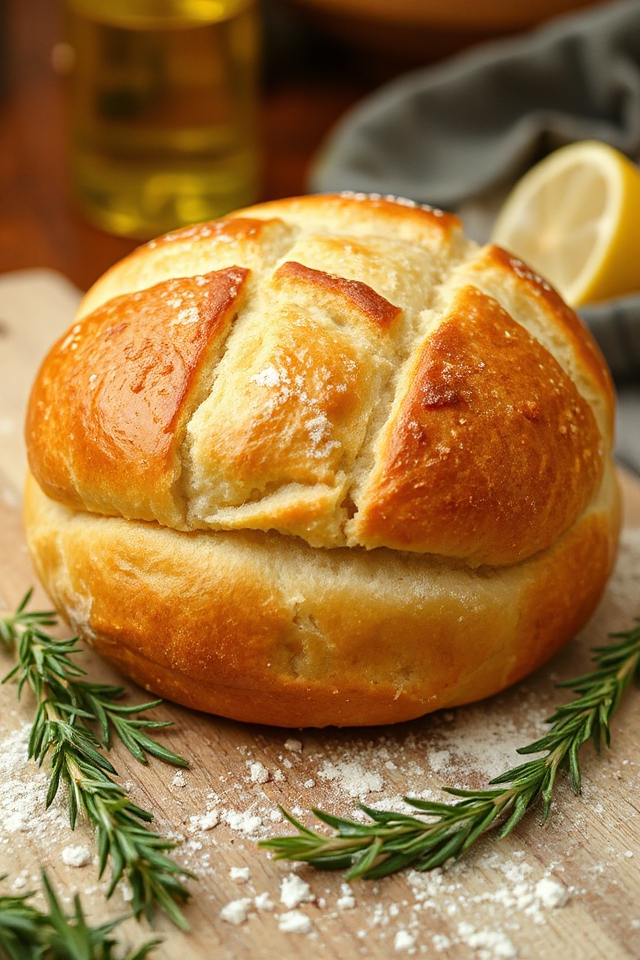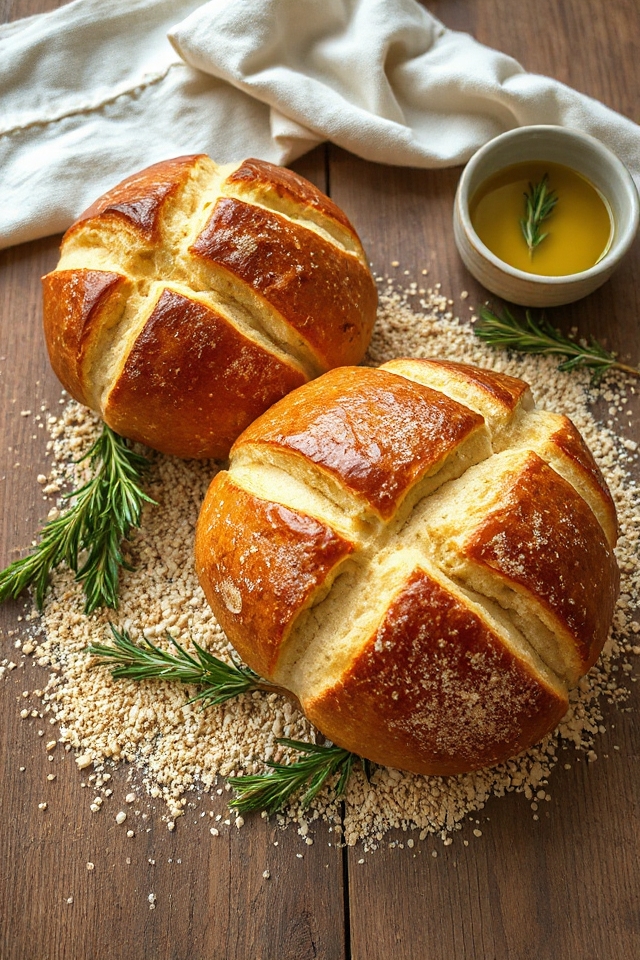Why You’ll Love This Rosemary Olive Oil Bread Recipe
If you’re looking for a bread that’s not just delicious but also versatile, you’ll love this Rosemary Olive Oil Bread recipe.
It’s perfect for any occasion, whether you’re serving it alongside a hearty soup or enjoying it with a simple salad. The aromatic rosemary adds a fragrant twist, while the olive oil gives it a rich, moist texture.
Plus, it’s incredibly easy to make, even for beginners. The delightful crust and soft interior make every bite a treat.
Trust me, once you try it, you’ll find yourself baking it again and again. It’s a true crowd-pleaser!
Ingredients of Rosemary Olive Oil Bread
When it comes to baking bread, having the right ingredients is key to achieving that perfect loaf. For this Rosemary Olive Oil Bread, you’re in for a treat because the ingredients aren’t only simple but also quite accessible. You might already have some of these staples in your pantry.
Plus, the combination of rosemary and olive oil brings a delightful Mediterranean flair to your kitchen. So, let’s plunge into what you’ll need to whip up this aromatic bread!
Ingredients for Rosemary Olive Oil Bread:
- 1 teaspoon active dry yeast
- 1 1/2 cups water (105-115 degrees Fahrenheit)
- 3 tablespoons extra virgin olive oil (plus more for brushing)
- 3 cups unbleached all-purpose flour
- 1/3 cup unbleached all-purpose flour (for kneading)
- 1/2 cup whole wheat flour (preferably organic)
- 1/4 cup fresh rosemary (finely chopped)
- 2 tablespoons kosher salt
- Cornmeal (for sprinkling)
Now, before you rush off to the store, let’s consider a few things about these ingredients. For instance, fresh rosemary really takes this bread to the next level.
Dried rosemary might be a substitute in a pinch, but it just doesn’t have that same aromatic punch. And while you might be tempted to skip the cornmeal for sprinkling, trust me, it adds a lovely crunch to the bottom of your loaves.
Speaking of salt, if you’re sensitive to it, feel free to reduce the amount; it won’t hurt the bread at all. Finally, using high-quality extra virgin olive oil will enhance the flavor, so don’t skimp on that.
Baking is all about balance, after all, and each ingredient plays a role in creating that perfect loaf of rosemary goodness.
How to Make Rosemary Olive Oil Bread

Making Rosemary Olive Oil Bread is an experience that’s as delightful as the smell that will fill your kitchen. To start, you’ll need 1 teaspoon of active dry yeast, which you’ll dissolve in 1 and 1/2 cups of warm water (make sure it’s between 105-115 degrees Fahrenheit). This is the point where the magic begins; allow the yeast to proof for about three minutes. You might be tempted to jump ahead, but patience is key here.
Once that yeast is all bubbly and frothy, stir in 2 cups of your basic bread sponge and 3 tablespoons of extra virgin olive oil. Your hands will get a little messy, but that’s just part of the fun, right? Toss in 1/4 cup of finely chopped fresh rosemary and 2 tablespoons of kosher salt, mixing everything together until it’s a sticky, wet dough.
Now, grab 3 cups of unbleached all-purpose flour and 1/2 cup of whole wheat flour, and mix those into your dough. You’re looking for a mass that gathers nicely but is still a bit sticky. At this point, turn that dough out onto a lightly floured surface and let it rest for three minutes—this is a great time to admire your work, or maybe sip on a cup of coffee.
After the rest, knead in just enough of the 1/3 cup of flour you set aside to make a smooth and elastic dough. Shape it into a ball and place it in a lightly oiled bowl, brushing the top with a bit more olive oil. Cover it with plastic wrap and pop it in the fridge overnight. Yes, overnight. You can do it! The long wait will lead to a bread that’s bursting with flavor.
The next day, take your dough out and let it warm up in a draft-free spot for about two hours. This is where the anticipation really builds. Once it’s nice and puffy, sprinkle cornmeal onto a baking sheet and divide that beautiful dough in half. Shape each piece into a ball, making sure to place the seam side down on the sheet.
Cover those with plastic wrap and let them rise until they’re doubled in size—this should take around 2 to 2 and a half hours. Preheat your oven to 425 degrees, and while that’s heating up, you can brush the loaves again with olive oil and make a tic-tac-toe pattern on top with a razor blade. This is the fun part.
Pour boiling water into a pan on the bottom of the oven for steam, and then slide your loaves onto the baking stone. Bake for 20 minutes, lower the temperature to 350 degrees, and then let them bake for another 30-35 minutes until they’re gloriously golden and sound hollow when tapped.
After brushing with more olive oil, let them cool on a rack, and there you have it—a loaf of Rosemary Olive Oil Bread that’s sure to impress. Just don’t be surprised when it disappears faster than you can say “delicious.”
Rosemary Olive Oil Bread Substitutions & Variations
After you’ve mastered the art of baking Rosemary Olive Oil Bread, you might want to experiment with some substitutions and variations to suit your taste.
For a nuttier flavor, try using spelt or rye flour instead of all-purpose flour. If you love garlic, adding minced fresh garlic can elevate the bread. You can also swap rosemary for other herbs like thyme or oregano for a different twist.
For a bit of sweetness, consider incorporating a tablespoon of honey or maple syrup. Don’t hesitate to mix in olives or sun-dried tomatoes for extra flavor and texture.
Enjoy your creative baking!
Additional Tips & Notes
To guarantee your Rosemary Olive Oil Bread turns out perfectly every time, I recommend paying attention to the temperature of your ingredients. Using warm water helps activate the yeast, while room temperature olive oil blends seamlessly into the dough.
I also suggest measuring the rosemary after chopping for the best flavor. If you prefer less salt, feel free to halve it; it’ll still be delicious.
Don’t rush the rising time; letting the dough double in size is essential for texture. Finally, make sure your oven is properly preheated to achieve that perfect crust.
Happy baking!
